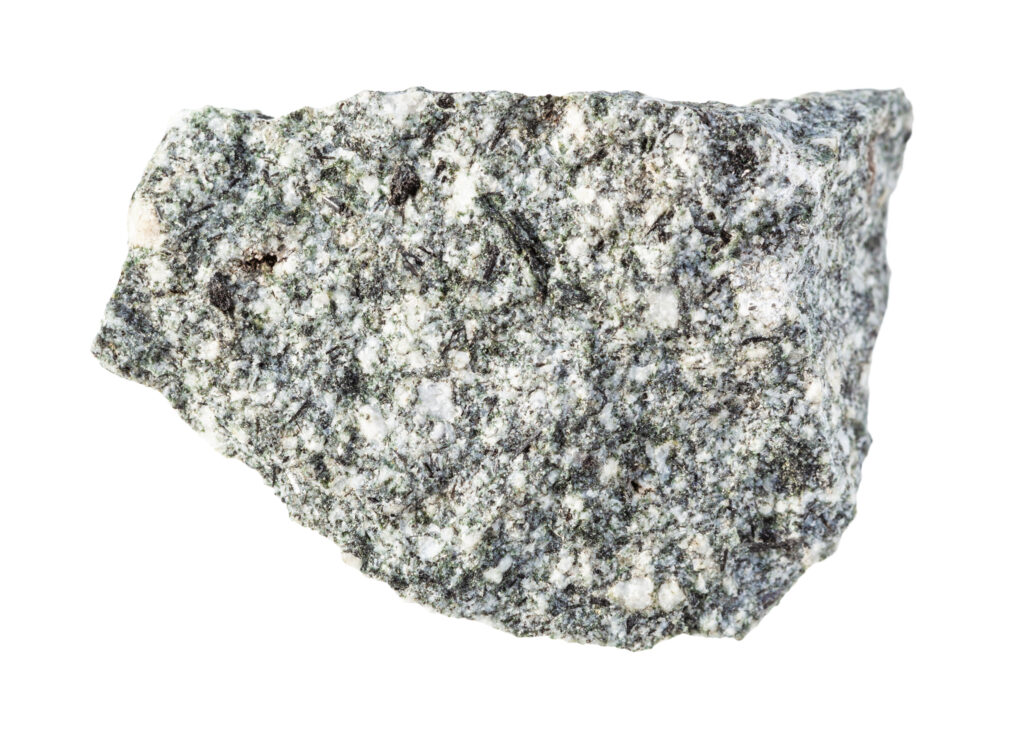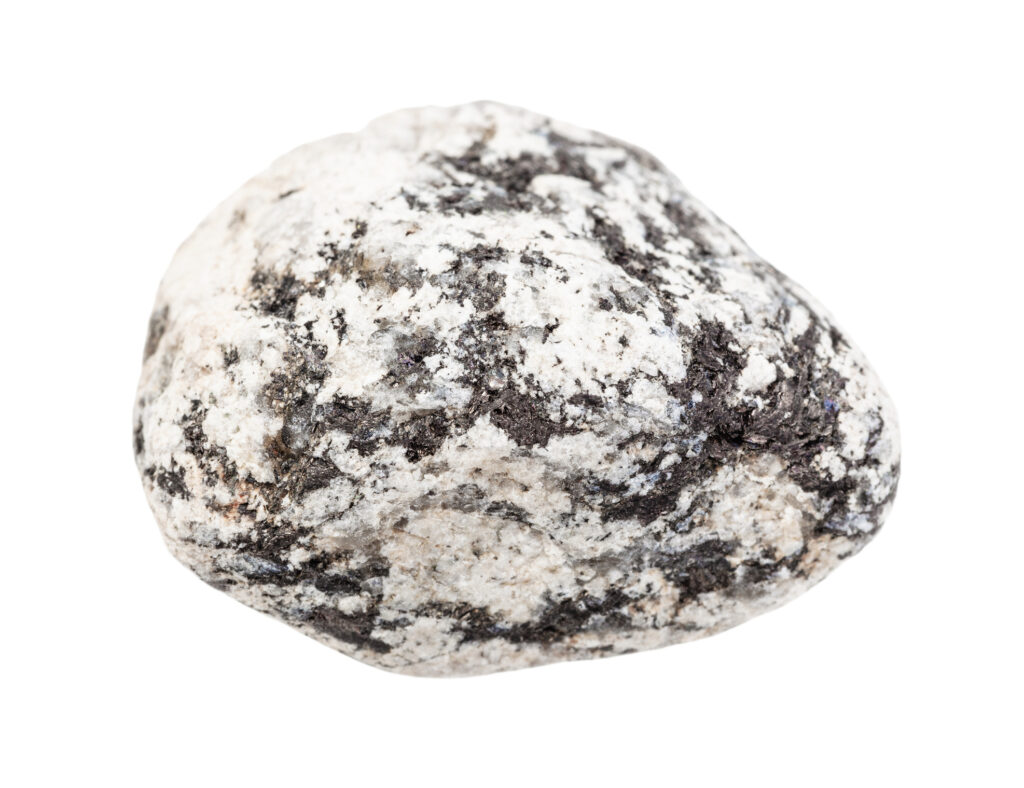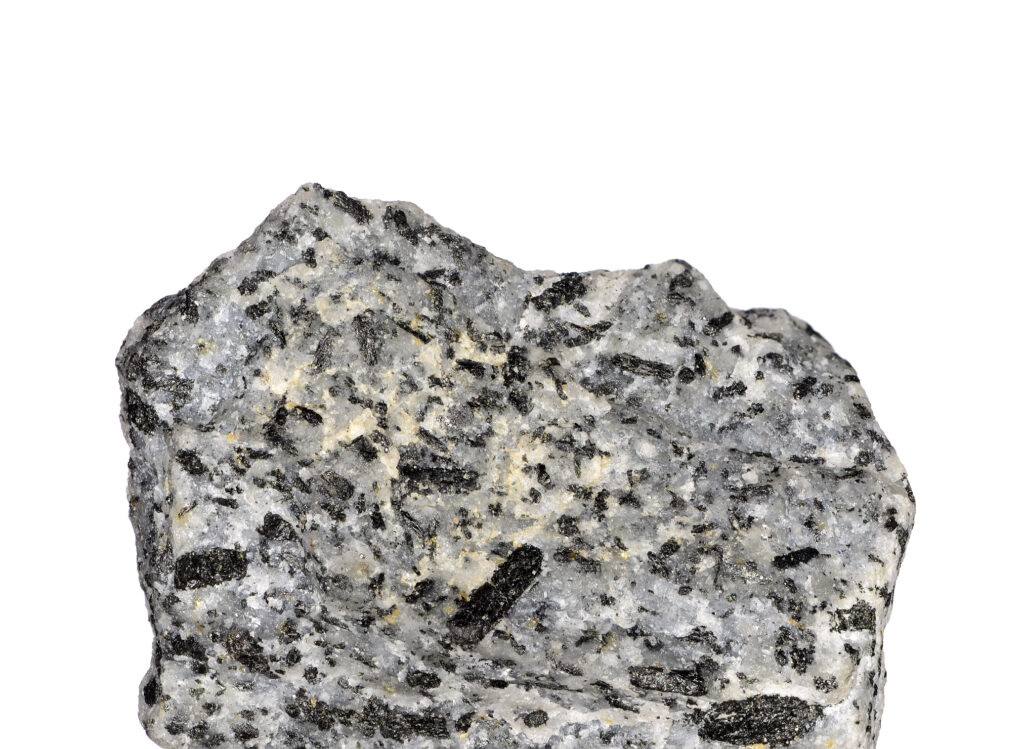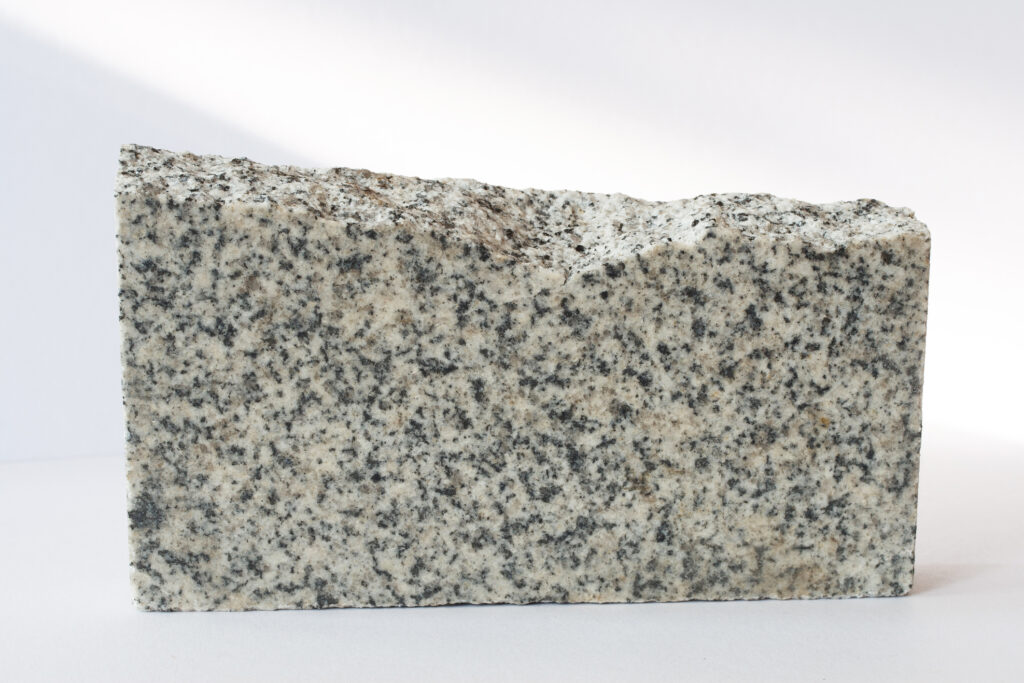Diorite is a fairly common rock type, but many people have never even heard of it. Chances are good that you have seen and touched diorite many times in your life, whether or not you were aware of it at the time. Because of its innate strength, beauty, and variety, it is also very popular with amateur collectors and for decorative use in construction.
The biggest reason diorite is not as well-known as it should be is that it is often confused with granite. This is perfectly understandable because diorite and granite are superficially very similar rocks that share many of the same physical properties. It can be difficult to know exactly what diorite looks like and how to identify it, but it is relatively simple if you know what to look for.
Diorite is an intrusive igneous rock composed primarily of plagioclase feldspar and smaller amounts of mafic minerals like hornblende and biotite. It has a phaneritic texture, meaning its interlocking crystals can be seen with the naked eye. It is known for having a characteristic ‘salt and pepper’ appearance.
Diorite is intermediate in composition between granite and gabbro. While diorite is a clearly defined rock type, it can sometimes be hard to distinguish it from closely related rocks – especially if you don’t have access to sophisticated testing methods. I’ll walk you through how to identify diorite, what it looks like, and where it can be found.
What Does Diorite Look Like?
Diorite is one of the most common igneous rocks in the world. Most people have seen it many times in their life – probably without realizing it. Diorite is intermediate in composition between felsic granite and mafic gabbro, which often makes it difficult to identify as a unique rock type.
In everyday life, it is relatively unimportant to be able to distinguish between diorite and granite, so people often just label everything that remotely meets the description as ‘granite’ and call it a day. But if you’re actually interested in geology and knowing what kind of rocks you have you probably want to be more specific than that. So, what does real diorite actually look like?
Diorite has a coarse-grained texture with large, interlocking crystals of white to off-white plagioclase feldspar and darker, mafic minerals like hornblende, biotite, and pyroxene. Its crystals are roughly equal-sized and it is intermediate in color with a characteristic ‘salt and pepper’ appearance.
One of the defining characteristics of diorite is its lack of quartz. Rocks like granite and granodiorite have quite a bit of quartz (over 20%) but diorite is almost completely devoid of any visible quartz grains – less than 5%.

While all diorite meets this general description, there is some variation in how it can look from location to location. The difference in their appearance is driven by the mineralogy of each type of diorite and, to a lesser extent, the subtle differences in their textures (crystal sizes).
Color is Driven by Mineralogy
The major mineral present in all diorite is plagioclase feldspar. Alkali feldpars are also usually present, at up to 35% of the total feldspar content in some dioritoids. Each of these minerals can present itself in different ways. The plagioclase feldspar in true diorite is rich in sodium, typically a species called andesine.
Tip: “Dioritoid” refers to rocks very closely related to true diorite. In the field and in common practice, most dioritoids are simply referred to simply as ‘diorite’.
Quartz is almost entirely absent from true diorite. In some dioritoids, however, it can be present at up to 20% of the total rock volume. It usually appears in diorite as translucent, light gray, or off-white. Some varieties may have more impurities which make the quartz crystals an opaque gray or white color. In any case, quartz is not a significant contributor to diorite’s overall light color because it simply isn’t prevalent enough.
Feldspar has much more variety than quartz. It is actually a group of minerals that can be divided into two main types: plagioclase feldspar and alkali feldspar. These two types of feldspar can look quite different from one another, and can even vary significantly in appearance themselves. Both are present in diorite.
Plagioclase feldspar is by far the most abundant mineral in diorite, making up over 65% of the total feldspar content. In true diorite, this percentage is over 95%. Being able to distinguish between the two types of feldspar is perhaps the most important (and most difficult) aspect of identifying a rock as diorite as opposed to syenite, which has more alkali feldspar than plagioclase. While this can sometimes be tricky, there are some easy-to-spot differences that can often help you see the difference and further understand your rock.
Both alkali feldspar and plagioclase feldspar can be white, but alkali feldspar is also very commonly salmon-pink or even darker pink, bordering on red. Plagioclase feldspar usually has visible striations in its crystals that may be visible if the individual crystals are large enough.
Some of the most common accessory minerals (sometimes making up to 40% of the total rock volume) in diorite are mica, hornblende, and pyroxene. The mica (usually biotite, a dark variety of mica), forms very flaky ‘books’ as crystals in the rock. Hornblende and pyroxene will almost always look like dark, blocky crystals interspersed throughout the diorite.
The accessory minerals in diorite give it a ‘salt and pepper’ appearance. There is usually about twice as much white as there is black, but the ratio can sometimes look about even.
Texture of Diorite
One of the defining features of diorite’s appearance is its texture. All diorite is coarse-grained, meaning that you can see the individual crystals in the rock. This texture is known as ‘phaneritic’, and it forms when magma cools slowly and allows the crystals enough time to grow before becoming completely solidified.
While all diorites are phaneritic, it is also possible (and even common) to describe their texture in other ways. Rocks can be described as having more than one texture as long as the texture types are not mutually exclusive.
Most diorite is ‘equigranular‘, which means that all of the crystals are approximately the same size. So, a granitic rock may be described as ‘phaneritic and equigranular’ if you can see similarly-sized crystals with the naked eye.
Some diorites can have a ‘porphyritic‘ texture. This indicates that there are larger crystals called ‘phenocrysts’ in a groundmass of smaller crystals. So if a diorite has large feldspar crystals surrounded by smaller (but still visible) mica and hornblende crystals you could describe it as ‘porphyritic and phaneritic’.
How to Identify Diorite
Diorite has a reasonably distinctive look, but it is often confused for closely-related rock types. If you aren’t overly familiar with how it’s defined and what it looks like it can be easy to misidentify it as something else entirely. As with any rock, it is important to take a systematic approach when identifying diorite.
To identify diorite, first look to see if you can make out individual crystals with the naked eye. Try to identify large amounts of whitish plagioclase feldspar, with lesser amounts of pinkish alkali feldspar and virtually no quartz. Dark, mafic minerals like biotite and hornblende can make up to 40% of the rock.
A rock must meet all of these requirements to be considered a diorite:
- Igneous – Formed from cooling magma, with interlocking crystal grains.
- Coarse-grained – Phaneritic texture with crystals visible to the naked eye
- Intermediate Mineralogy – High feldspar content with more plagioclase than alkali feldspar and up to 40% dark (mafic) minerals
- Massive – No internal structures or layering

If your rock meets all of those criteria then it is very likely a diorite, or at least something very closely related. Rocks with mineralogies very similar to diorite are considered ‘dioritoids’, and many people simply group them all together when a specific identification isn’t overly important.
Tip: This article is part of my igneous rock identification series. To read more about how to identify all igneous rocks, check out my article here.
When observing and identifying a rock like diorite it can often be useful to use a hand lens like this one from Amazon. This allows you to see the individual crystal grains more clearly and often helps you identify the specific species of minerals present in a rock.
What Is Diorite Made Of?

As I mentioned above, diorite is largely defined by a specific mineralogy. All rocks are made from one or more minerals, and in order to fully understand a rock like diorite you have to know what those minerals are.
Diorite is primarily made from large amounts of plagioclase feldspar, with smaller amounts of alkali feldspar and mafic minerals like amphibole, biotite, and hornblende. The mineral composition of diorite consists of 0% to 20% quartz, and 65% to 100% of the total feldspar must be plagioclase.
This definition is very specific, but without sophisticated methods for measuring mineral types and percentages it is impractical (or even impossible) for us to determine if a diorite-like rock falls into those specific percentage ranges.
The best you can do is to first estimate the percentage of quartz in the rock. If it is between 0 and 20% quartz then you know it is probably either diorite or syenite. Then, estimate the percentage of the feldspar that is plagioclase vs alkali feldspar. If there is noticeably more plagioclase than alkali feldspar then you can confidently call your rock ‘diorite’.
It is useful to know what some closely-related rock types are called and what their mineralogy looks like. These rocks all form in similar ways, but vary in their mineral’s relative proportions.
- Granite – Quartz-rich with more alkali feldspar than plagioclase feldspar
- Syenite – Quartz-deficient with very more alkali feldspar than plagioclase
- Granodiorite – Quartz-rich with more plagioclase than alkali feldspar
Where Is Diorite Found?
Diorite is a fairly widespread igneous rock, but you might not realize just how often you see it because it is so easy to confuse with granite and other plutonic rocks. But as common as diorite is, you can’t find it just anywhere.
Diorite is most commonly found near subduction zones in areas with a history of volcanism and mountain building. It is exposed on the surface where erosion has stripped away shallower rock to reveal the diorite beneath. It is also common to find diorite in riverbeds downstream from large dioritic exposures.
Because diorite forms beneath the surface of the earth, the vast majority of it isn’t visible or accessible to us. But, through the tremendous mountain-building power of plate tectonics, large mountain ranges of dioritic rock are relatively common throughout the world. The large igneous intrusions are thrust upwards to the surface to form impressive mountains which endure for millions of years.
Diorite is composed of relatively hard minerals (primarily feldspars) which make it incredibly durable. Once it is exposed to the surface it takes a long time for it to break down. Pieces of diorite can survive in a river for great distances, which is why it’s so common to find pieces downriver from its source.
You can look for diorite formations near you using this excellent interactive map from the USGS. I have a video about how to use this tool in my Practical Rock Identification System, plus even more information on how to identify diorite and other rocks.
How Does Diorite Form?
We’ve learned all about what diorite looks like, what it is composed of, and generally where it’s found, but I have only briefly touched on how it’s actually formed. The creation of diorite is a fascinating process that always follows a few simple rules but can vary significantly in the details.
Diorite forms when basaltic magma rises and intrudes into the granitic rock of a continental plate. The granitic rock is partially melted and absorbed into the basaltic magma, resulting in a mixture of the two. The melt then slowly cools and solidifies beneath the surface, allowing relatively large crystals to form.
The creation of diorite really begins with oceanic plates, which are made of basalt. At subduction zones, oceanic plates sink below continental plates which are generally made of more granitic rock. Once the oceanic plate reaches a certain depth and temperature it begins to melt, forming basaltic magma.
That basaltic magma rises towards the surface and comes into contact with the granitic rock above, causing it to melt and absorb into the magma body. Eventually, that intermediate mixture of magma either erupts to the surface and becomes fine-grained andesite or cools slowly within the Earth to become coarse-grained diorite.
Because the composition of the source magma is never exactly the same from one diorite to another and the surrounding environment is always different, there can be quite a lot of variation in how the magma cools and the crystals form.
If the surrounding rock is relatively cool then the crystals formed on the edges of the igneous intrusion are likely to be smaller. Similarly, if the intrusion is very large then the crystals in the center of the magma body are likely to become very large because they have such a long time to cool down and crystalize.
As the individual crystals of diorite’s various minerals cool down, they eventually run into each other and they run out of room. Crystallization will continue until all of the magma is solidified, leaving behind interlocking crystals with virtually no porosity between them.
Because diorite forms as one solid mass, it contains no internal structures like bedding or banding. It looks the same from all directions and you can’t tell which direction was ‘up’ at the time of crystallization. This is called a ‘massive’ rock.
What Is Diorite Used For?

Chances are good that you have seen plenty of diorite in your day-to-day life, but it can be easy to miss if you’re not paying attention. Because diorite is similar in many respects to granite it should come as no surprise that they are used in many of the same applications. Diorite has been in use for thousands of years because of its durability, strength, prevalence, and striking appearance.
Diorite is most commonly used for interior and exterior building applications. Highly polished diorite is an extremely popular material for countertops, while rough-cut diorite is one of the most prevalent components of buildings, bridges, and other structures.
Like most rocks, diorite is very strong in compression. This means it can withstand a great deal of ‘squeezing’ without breaking, making it ideal for use in construction projects with large overburden stresses.
What really sets diorite (and granite) apart is its ability to accept a polish and its resistance to weathering. The highly polished ‘granite’ countertops you’re used to seeing in modern buildings are often actually made of diorite. They are made possible by the fact that feldspar and quartz are easily brought to a high shine.
One of the biggest reasons diorite and similar rocks are so popular as a building material is because it doesn’t break down in the rain, ice, and wind as easily as other rocks.
This article is part of my rock identification series. To learn more about identifying rocks, check out my full in-depth guide here.
